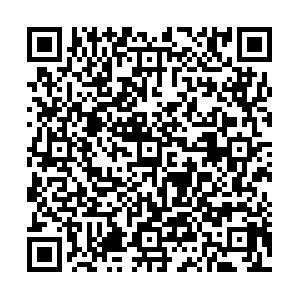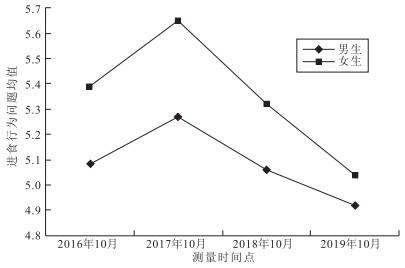Dynamic developmental trajectory of problem eating behavior among students from one university of Jiangsu Province
-
摘要:
目的 探究大学生进食行为问题的发展轨迹,为进食行为问题的早期预防和干预提供依据。 方法 2016—2019年历时4年对江苏省某高校整群抽取的5 372名新生,使用大学生进食行为问题量表进行追踪调查。 结果 大学生进食行为问题随时间呈现“先升后降”的发展趋势(5.17±1.36,5.39±1.53,5.14±1.42,4.96±1.37)(F=112.12,P < 0.01),大二阶段学生进食行为问题的水平最高。大学生进食行为问题的发展轨迹可以分为2个类型,分别是缓慢减少组(86.7%)和缓慢增加组(13.3%)。大学生进食行为问题的发展轨迹存在性别效应,女生进食行为问题的初始均值、变化速度高于男生。 结论 大学生进食行为问题存在群体异质性和性别效应,高校要针对不同类别采取不同干预策略。 Abstract:Objective To explore the dynamic developmental trajectory of problem eating behavior among college students, and to provide evidence for the early prevention and intervention of eating problems. Methods A cluster sample of 5 372 freshmen from a university in Jiangsu Province were included and followed up for 4 years by using the eating behavior problems scale. Results The problem eating behavior of college students in Jiangsu Province showed a decreasing after increasing trend(5.17±1.36, 5.39±1.53, 5.14±1.42, 4.96±1.37)(F=112.12, P < 0.01), and prevalence of problem eating behavior was highest among sophomores. The developmental trajectory of eating behavior problems in college students could be divided into slow decreasing (86.7%) and slow increasing (13.3%) groups. In addition, sex-specific developmental trajectory of problem eating behavior was observed, with initial mean level and change speed of female students were signicantly higher than that of male students. Conclusion There are group heterogeneity and sex-specific effect in problem eating behavior of college students, which needs specific intervention strategies provided from colleges. -
Key words:
- Eating disorders /
- Mental health /
- Questionnaires /
- Students
-
表 1 大学生进食行为问题潜在类别分析模型适配情况
Table 1. Summary table of potential category analysis models for college students' eating behavior problems
模型 K Log(L) AIC aBIC Entropy LMR BLRT 类别概率 1 10 -37 116.269 74 252.537 74 286.650 - - - - 2 13 -36 163.803 72 353.605 72 397.952 0.921 0.000 < 0.01 0.867/0.133 3 16 -35 936.798 71 905.595 71 960.175 0.939 0.394 0.403 0.004/0.867/0.130 4 19 -35 820.412 71 678.825 71 743.639 0.913 0.206 0.214 0.148/0.814/0.034/0.004 5 22 -35 174.366 70 392.732 70 467.780 0.953 0.021 0.023 0.001/0.075/0.721/0.018/0.184 -
[1] 胡彬, 包盛楠, 冯成志. 进食障碍亚临床状态女大学生的内隐食物态度[J]. 中国健康心理学杂志, 2012, 20(6): 835-839. https://www.cnki.com.cn/Article/CJFDTOTAL-JKXL201206018.htmHU B, BAO S N, FENG C Z. The implicit attitude on food of female college students with the sub-clinical eating disorders[J]. Chin J Health Psychol, 2012, 20(6): 835-839. https://www.cnki.com.cn/Article/CJFDTOTAL-JKXL201206018.htm [2] JOHNSON J G, COHEN P, KASEN S, et al. Eating disorders during adolescence and the risk for physical and mental disorders during early adulthood[J]. Arch General Psychiatry, 2002, 59(6): 545-552. doi: 10.1001/archpsyc.59.6.545 [3] ANGLÉ S, ENGBLOM J, ERIKSSON T, et al. Three factor eating questionnaire-R18 as a measure of cognitive restraint, uncontrolled eating and emotional eating in a sample of young Finnish females[J]. Int J Behav Nutr Phys Act, 2009, 6(1): 41-47. doi: 10.1186/1479-5868-6-41 [4] 章晓云, 钱铭怡. 进食障碍的心理干预[J]. 中国心理卫生杂志, 2004, 18(1): 31-34. doi: 10.3321/j.issn:1000-6729.2004.01.012ZHANG X Y, QIAN M Y. Psychological intervention on eating disorder[J]. Chin Ment Health J, 2004, 18(1): 31-34. doi: 10.3321/j.issn:1000-6729.2004.01.012 [5] 李婧, 徐艺珊, 李新宇. 大学生非典型性进食障碍与身体自尊的关系研究[J]. 中国临床心理学杂志, 2009, 17(3): 345-347. https://www.cnki.com.cn/Article/CJFDTOTAL-ZLCY200903034.htmLI J, XU Y S, LI X Y. Correlation between atypical eating disorder and body-esteem of college students[J]. Chin J Clin Psychol, 2009, 17(3): 345-347. https://www.cnki.com.cn/Article/CJFDTOTAL-ZLCY200903034.htm [6] 李辉, 田苑, 王亚萍. 西安市初中生进食行为问题和家庭因素的关系研究[J]. 中国儿童保健杂志, 2012, 20(8): 693-695. https://www.cnki.com.cn/Article/CJFDTOTAL-ERTO201208011.htmLI H, TIAN Y, WANG Y P. Study of relationship between eating behavior problems and familial factor among middle school students in Xi'an[J]. Chin J Child Health Care, 2012, 20(8): 693-695. https://www.cnki.com.cn/Article/CJFDTOTAL-ERTO201208011.htm [7] 耿燕. 自我客体化与大学生进食行为问题: 内化和外化身体羞耻的多重中介作用[J]. 中国临床心理学杂志, 2020, 28(2): 152-156, 205. https://www.cnki.com.cn/Article/CJFDTOTAL-ZLCY202002030.htmGENG Y. Self-objectification and eating behavior problems in college students: multiple mediating effects of internalized body shame and externalized body shame[J]. Chin J Clin Psychol, 2020, 28(2): 152-156, 205. https://www.cnki.com.cn/Article/CJFDTOTAL-ZLCY202002030.htm [8] 田志鹏, 刘勇, 杨坤, 等. 无聊与进食行为问题的关系: 自我控制的中介作用[J]. 中国临床心理学杂志, 2016, 24(6): 1046-1050. https://www.cnki.com.cn/Article/CJFDTOTAL-ZLCY201606018.htmTIAN Z P, LIU Y, YANG K, et al. Effects of boredom proneness and state boredom on eating behavior: mediating role of self-control[J]. Chin J Clin Psychol, 2016, 24(6): 1046-1050. https://www.cnki.com.cn/Article/CJFDTOTAL-ZLCY201606018.htm [9] 张彤彤. 体育锻炼在女大学生完美主义与进食障碍间的调节作用[J]. 中国学校卫生, 2018, 39(2): 236-238, 244. doi: 10.16835/j.cnki.1000-9817.2018.02.023ZHANG T T. The moderating effect of physical exercise on perfectionism and diet disorder of female college students[J]. Chin J Sch Health, 2018, 39(2): 236-238, 244. doi: 10.16835/j.cnki.1000-9817.2018.02.023 [10] 孟庆新, 刘勇, 杨坤. 大学生冲动性在无聊倾向与进食行为间的中介作用[J]. 中国学校卫生, 2017, 38(2): 224-227. doi: 10.16835/j.cnki.1000-9817.2017.02.019MENG Q X, LIU Y, YANG K. Boredom proneness and eating behavior among college students: mediating role of impulsivity[J]. Chin J Sch Health, 2017, 38(2): 224-227. doi: 10.16835/j.cnki.1000-9817.2017.02.019 [11] 方晓义, 袁晓娇, 胡伟, 等. 中国大学生心理健康筛查量表的编制[J]. 心理与行为研究, 2018, 16(1): 111-118. doi: 10.3969/j.issn.1672-0628.2018.01.015FANG X Y, YUAN X J, HU W, et al. Establishment of mental health screening scale for Chinese college students[J]. Stud Psychol Behav, 2018, 16(1): 111-118. doi: 10.3969/j.issn.1672-0628.2018.01.015 [12] 关丹丹, 王建平. 北京女大学生进食障碍调查分析[J]. 中国心理卫生杂志, 2003, 17(10): 672, 665. https://www.cnki.com.cn/Article/CJFDTOTAL-ZXWS200310004.htmGUAN D D, WANG J P. Investigation and analysis on eating disorder of female college students in Beijing[J]. Chin Ment Health J, 2003, 17(10): 672, 665. https://www.cnki.com.cn/Article/CJFDTOTAL-ZXWS200310004.htm [13] 宫盛花, 苏骁征, 叶宝娟. 贵州省少数民族大学生心理健康素质培养现状的调查研究: 以苗族、侗族为例[J]. 中国特殊教育, 2011(6): 85-90. https://www.cnki.com.cn/Article/CJFDTOTAL-ZDTJ201106018.htmGONG S H, SU X Z, YE B J. An Investigation into the current mental health training of ethnic minority college students in Guizhou Province[J]. Chin J Special Educ, 2011(6): 85-90. https://www.cnki.com.cn/Article/CJFDTOTAL-ZDTJ201106018.htm [14] 吕素香. 大二低潮现象原因与对策[J]. 中国高等教育, 2015(10): 56-58. https://www.cnki.com.cn/Article/CJFDTOTAL-ZGDJ201510021.htmLYU S X. Causes and countermeasures of sophomore low tide phenomenon[J]. Chin Higher Educ, 2015(10): 56-58. https://www.cnki.com.cn/Article/CJFDTOTAL-ZGDJ201510021.htm [15] 赵霞, 孙宏艳, 张旭东. 我国城市青少年健康生活方式的发展趋势与改进[J]. 中国青年研究, 2019(4): 61-66. doi: 10.3969/j.issn.1002-9931.2019.04.009ZHAO X, SUN H Y, ZHANG X D. Development trend and improvement of healthy lifestyle of urban adolescents in China[J]. Chin Youth Stud, 2019(4): 61-66. doi: 10.3969/j.issn.1002-9931.2019.04.009 [16] STRIEN T V, FRIJTERS J E R, BERGERS G P A, et al. The Dutch Eating Behavior Questionnaire (DEBQ) for assessment of restrained, emotional, and external eating behavior[J]. Int J Eat Dis, 1986, 5(2): 295-315. doi: 10.1002/1098-108X(198602)5:2<295::AID-EAT2260050209>3.0.CO;2-T -







 下载:
下载:

